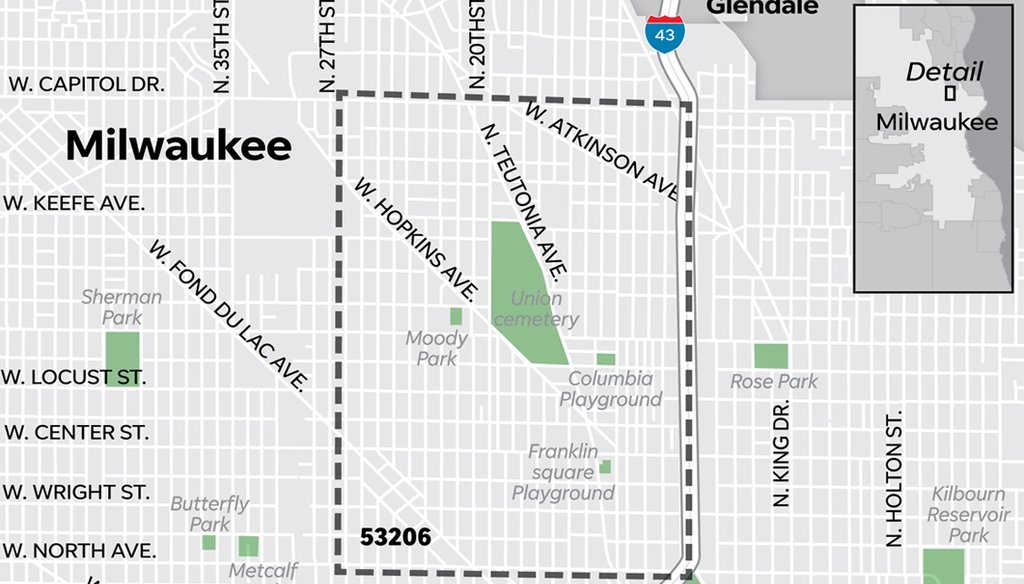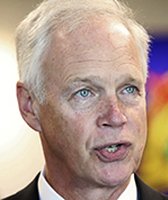Stand up for the facts!
Our only agenda is to publish the truth so you can be an informed participant in democracy.
We need your help.
I would like to contribute

Milwaukee's 53206 ZIP code faces deep, longstanding challenges. But sometimes its standing by the numbers gets exaggerated.
Milwaukee’s 53206 may be the most famous -- or perhaps infamous -- ZIP code in Wisconsin.
When Milwaukee’s ills -- crime, poverty, poor housing -- are measured in studies, the ZIP code frequently comes out on top. For politicians and policymakers, the area has become a five-digit shorthand for dysfunction and decay. It has even been the subject of a documentary.
The ZIP code is bounded, roughly, by Interstate 43 to the east, 27th Street to the west, North Avenue to the south and Capitol Drive to the north.
To be sure, the area faces deep, long-standing challenges. But sometimes its standing by the numbers gets exaggerated.
Here is one example:
"Coming from the most incarcerated ZIP code in our state, I know how much opportunity means for our communities of color," Lt. Gov. Mandela Barnes tweeted on May 4, 2019. "Our administration wants to end these disparities and create a Wisconsin where everyone has a chance to thrive."
On one level, the most-incarcerated claim is a simple statistical one.
But there are many levels to the claim, which over the years has been repeated by so many politicians and amplified so many times by news accounts that it has been accepted as a truth: Not only do people say it’s the most incarcerated ZIP code in the state, it’s the worst in the nation.
Or even the world.
Analyzing the claim is complicated by many factors, from difficulty in obtaining solid data to the different ways that data can be sliced: Census tract vs. ZIP code vs. city vs. metro area. There’s this problem as well: Does "most incarcerated" mean those in prison now, or anyone who has served time in the past?
Thus, we are setting aside the Truth-O-Meter today to examine how this particular claim got exaggerated and what we know about incarceration in 53206 and in Milwaukee.
Behind the claim
The genesis of the claim appears to be a study -- "Wisconsin’s Mass Incarceration of African American Males: Workforce Challenges for 2013" -- prepared by John Pawasarat and Lois M. Quinn for the Employment and Training Institute at the University of Wisconsin-Milwaukee.
The report noted that Wisconsin was the worst state in the nation for African American incarceration, at 12.8%, based on 2010 census data. That was nearly double the national average of 6.7%.
The report went on to refer to 53206 as "ground zero for black male incarceration."
It noted two-thirds of Milwaukee County’s incarcerated African American men came from six ZIP codes in the poorest neighborhoods of Milwaukee and included a graphic showing the "concentration of released and incarcerated ex-offenders in Milwaukee ZIP code 53206."
The study looked not just at those in jail or prison at a given time, but also those who had been previously incarcerated.
The report did not claim 53206 as the most-incarcerated in the state but that was a leap that many easily made. And because the state was the worst in the nation, a second leap -- that 53206 is worst in the nation -- wasn’t far away.
Department of Corrections data
So where does 53206 stand?
Any close-to-definitive answer on this matter has to involve data from the Wisconsin Department of Corrections. But officials there told us they do not typically track whatever ZIP code is associated with an inmate’s most recent address.
That said, they agreed to run their data in that manner and shared the information with PolitiFact Wisconsin.
The DOC based its analysis on inmates in the prison system as of June 30, 2019, and each inmate’s address prior to entering the prison system, said spokeswoman Clare Hendricks.
That’s worth underlining: It does not take into account people who have served time, but are no longer behind bars. Nor does it account for any people currently incarcerated in county jails or federal prisons.
As of late August, there was a total Wisconsin inmate population of about 23,000. Roughly 5,000 inmates were omitted from DOC’s address analysis because the department was not able to find a pre-incarceration home address aside from a jail or other facility.
That left 18,105 inmates scattered across more than 700 Wisconsin ZIP codes.
Here’s how the top five ZIP codes broke down based on raw numbers:
-
53206 (Milwaukee near north side): 598 inmates
-
53209 (Milwaukee north side/Thurston Woods): 572
-
53208 (Milwaukee west side/Miller Valley): 467
-
53204 (Milwaukee near south side/Walker’s Point): 452
-
53210 (Milwaukee west side/Sherman Park): 451
So, by that measure, 53206 is the leader.
But the number of people living in each ZIP code can vary widely.
What about when you rank the state ZIP codes by the incarcerated number as a percentage of the adult population? Here is how that looks:
-
54861 (Northwest Wisconsin/Ashland County): 92 adults, 8 incarcerations, population proportion 8.70%
-
53702 (Madison/Dane County): 26 adults, 2 incarcerations, population proportion 7.69%
-
53203 (Milwaukee/Kilbourn Town): 1,320 adults, 53 incarcerations, population proportion 4.02%
-
53206 (Milwaukee near north side): 16,324 adults, 598 incarcerations, population proportion 3.66%
-
54442 (Lincoln County/North central Wisconsin): 801 adults, 26 incarcerations, population proportion 3.25%
So, by that measure, the 53206 ZIP code ranks fourth. It’s not even the top ZIP code in Milwaukee.
Worst in the nation?
A 2018 Brookings Institution report found that neighborhoods with high incarceration rates are "predominately black, or are otherwise non-white, have child poverty rates that are two to three times the national average, and have male unemployment rates substantially higher than the rest of the country."
That may sound like 53206, but the report’s list of the nation’s top 40 ZIP codes did not include any from Wisconsin, let alone 53206. That analysis, based on the rate (not raw numbers), put 37208 (Nashville, Tenn.) in the top spot, followed by 23704 (Portsmouth, Va.) and 76707 (Waco, Texas).
Nevertheless the claim that 53206 is the worst in the nation continues to be made.
The 2015 documentary film, "Milwaukee 53206," included an appearance by then-Milwaukee Police Chief Ed Flynn:
"We have a famous ZIP code, 53206, and I always hear about it because so many prisoners come from there," Flynn says in the film. "The homicide rate in 53206 is 250 per 100,000. Now, nobody should have to live in that kind of circumstance."
At one point in the documentary, a woman who was interviewed says the area’s incarceration rate is "one of the most incarcerated ZIP codes in the world."
A 2017 Milwaukee Neighborhood News Service report said: "In 53206, the population is 94 percent black with an average age of about 29. In this, the most incarcerated ZIP code in the country, 47.5 percent of people and two-thirds of children live below the poverty line."
A 2017 article in the Milwaukee Journal Sentinel noted "Even after 10 years of effort, researchers at the University of Wisconsin-Milwaukee failed to locate any other ZIP code in the nation with a matching per-capita share of residents who are or were incarcerated."
A Milwaukee Journal Sentinel 2018 article hearkened back to the original UWM study, noting it found 53206 "was the most incarcerated ZIP code in the state, with a majority of its men having spent time in jail or prison."
Indeed, Barnes’ chief of staff, Fred Ludwig, referred PolitiFact Wisconsin to that article when we asked him for back up to the claim.
"In regards to previously stating that 53206 is ‘our nation's most incarcerated zip code,’ this has been a commonly reported claim," Ludwig said in an email.
Ludwig noted an even more recent report (May 12, 2019), from FOX 6 News with this headline: "Screening of ‘Milwaukee 53206’ details what it’s like to live in the most incarcerated ZIP code in the US"
But that simply continues the circle.
The Milwaukee picture
A recent study by Harvard University’s Opportunity Insights policy and research institute examined incarceration rates for African American men in the 50 largest metro areas.
By that measure, Milwaukee came out on top (15.8 percent).
Shannon Felton Spence, press contact for the institute, said the statistic applies specifically to black men who grew up in Milwaukee (from age 0-23) "no matter where they are living now as adults, who were incarcerated on the day of the 2010 Census (April 1, 2010)."
A Sept. 1, 2019 article in the Milwaukee Journal Sentinel, citing the same Harvard data, noted:
When the incarceration rate was measured for all ethnicities, Milwaukee registered another statistical extreme: among all 73,500 census tracts anywhere within the United States, the tract that had the highest share of incarcerated males was in a Milwaukee north side neighborhood where 33.1 percent of the male population was incarcerated in the 2010 census (an average U.S. census tract encompasses 3,000 to 4,000 residents).
On Feb. 28, 2019, Marc V. Levine, founding director of the Center for Economic Development at the University of Wisconsin-Milwaukee, issued a study titled "Milwaukee 53206: The Anatomy of Concentrated Disadvantage."
The study digs deeply into the numbers driving the challenges faced by 53206, from employment to housing inequality. The section on incarceration noted the rates here are "staggeringly high," even as the report debunked the worst-in-the-nation claim.
In an email to PolitiFact Wisconsin, Levine noted "measuring incarceration at the zip code (or neighborhood) level is very complicated, and the data we have are imperfect and are not like a census enumeration."
The bottom line, from Levine’s report:
"Thus, even if characterizations of Milwaukee 53206 as the ‘most incarcerated’ ZIP code in America are hyperbole, this should not obscure the reality that mass incarceration is an integral component in the ‘ecosystem’ of concentrated disadvantage that continues to weigh on this beleaguered neighborhood."
That point is one that no one disputes.
And that, of course, is the underlying point politicians such as Barnes are making when they cite the status of 53206 -- even though it often gets blown out of proportion.
Our Sources
Twitter Mandela Barnes, May 4 2019.
John Pawasarat and Lois M. Quinn Wisconsin’s Mass Incarceration of African American Males: Workforce Challenges for 2013" Page 26.
Brookings Institution "Work and Opportunity Before and after incarceration, March 2018.
OnMilwaukee "Poverty drives epidemic of childhood trauma, panelists say," Nov. 25, 2017.
Milwaukee Journal Sentinel "53206 is Wisconsin’s most incarcerated ZIP code. Here are 4 more facts about the Milwaukee neighborhood.,"Dec. 31, 2018.
Milwaukee Neighborhood News Service, "Poverty drives epidemic of childhood trauma, panelists say," Nov. 17, 2017.
Fox6 Now "Screening of ‘Milwaukee 53206’ details what it’s like to live in the most incarcerated ZIP code in the US." May 12, 2019.
Email, Fred Ludwig, chief of staff, Lt. Gov. Mandela Barnes.
Email, Marc V. Levine, Professor Emeritus of History, Economic Development, and Urban Studies, Founding Director, Center for Economic Development at the University of Wisconsin-Milwaukee, June 19, 2019.
Email, Clare Hendricks, Wisconsin Department of Corrections, Deputy Communications Director, July 23, 2019.
Today’s TMJ-4, "Poverty level in 53206 zip code more than 3 times higher than the state level," Feb. 26, 2019.
Department of Corrections, inmate population Aug. 23, 2019.

















































